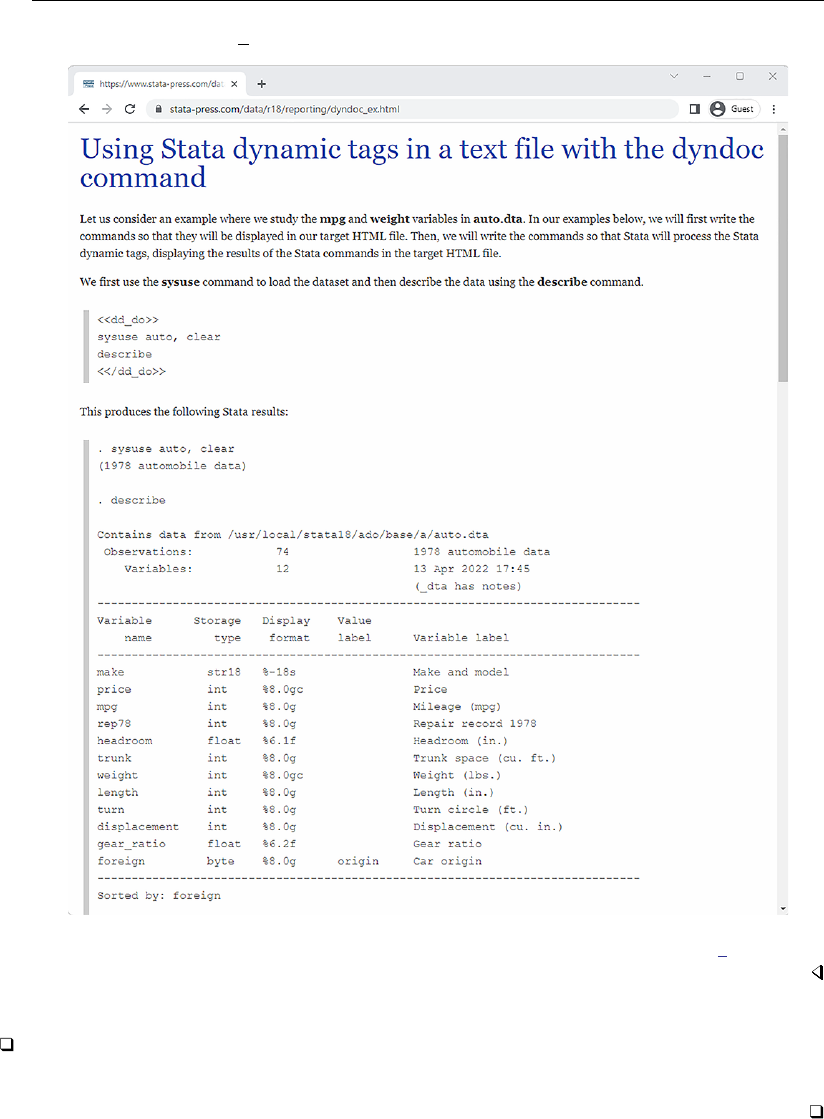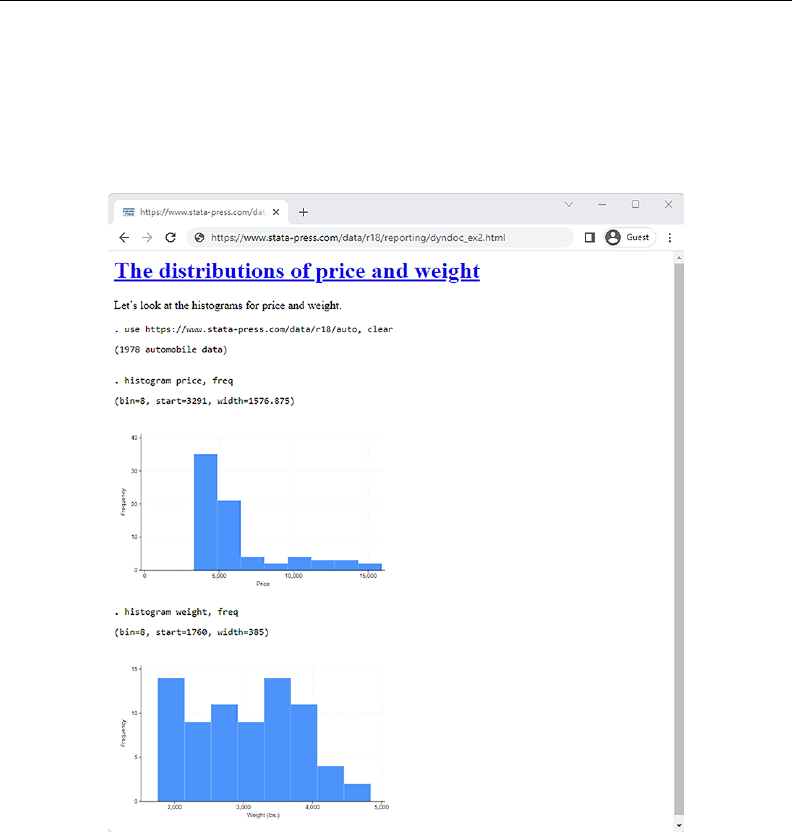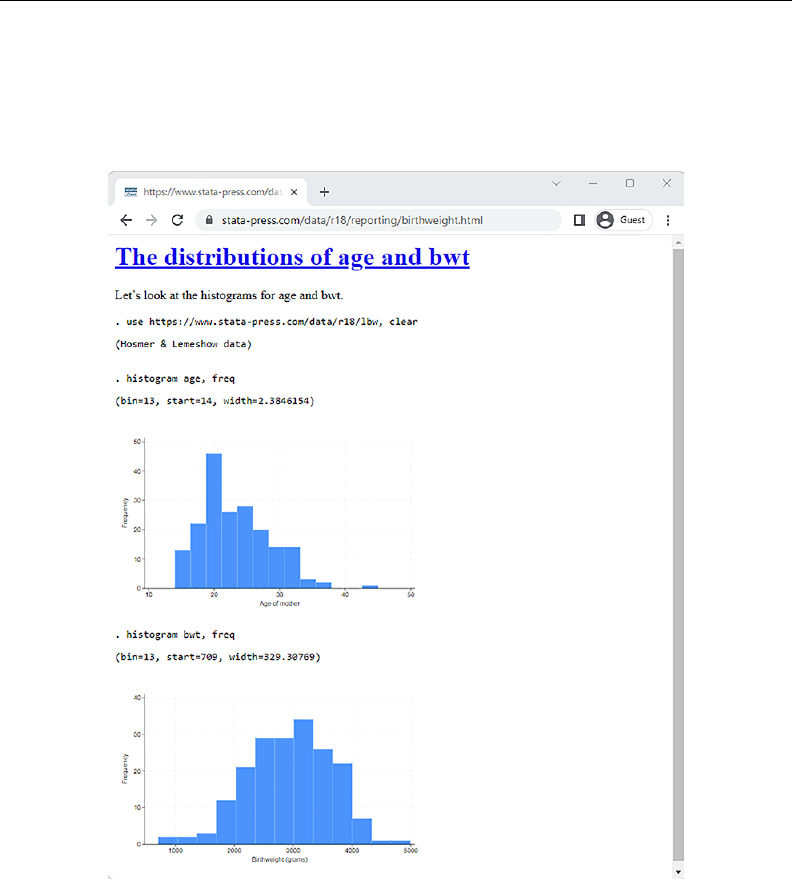
Title stata.com
dyndoc — Convert dynamic Markdown document to HTML or Word (.docx) document
Description Quick start Syntax Options Remarks and examples
References Also see
Description
dyndoc converts a dynamic Markdown document—a document containing both formatted text and
Stata commands—to an HTML file or Word document. Stata processes the Markdown text and Stata
dynamic tags (see [RPT] Dynamic tags) and creates the output file. Markdown is a simple markup
language with a formatting syntax based on plain text. It is easily converted to an output format
such as HTML. Stata dynamic tags allow Stata commands, output, and graphs to be interleaved with
Markdown text.
If you want to convert a Markdown document without Stata dynamic tags to an HTML file or Word
document, see [RPT] markdown. If you want to convert a plain text file containing Stata dynamic
tags to a plain text output file, see [RPT] dyntext. If you want to convert an HTML file to a Word
document, see [RPT] html2docx.
Quick start
Convert text file myfile.txt with Stata dynamic tags and Markdown formatting to an HTML file
with Stata output saved as myfile.html
dyndoc myfile.txt
Same as above, but save the HTML file as mydoc.html
dyndoc myfile.txt, saving(mydoc.html)
Same as above, and overwrite the existing mydoc.html
dyndoc myfile.txt, saving(mydoc.html) replace
Convert myfile.txt to a Word document saved as myfile.docx
dyndoc myfile.txt, docx
1

2 dyndoc — Convert dynamic Markdown document to HTML or Word (.docx) document
Syntax
dyndoc srcfile
arguments
, options
srcfile is a plain text file containing Markdown-formatted text and Stata dynamic tags.
arguments are stored in the local macros ‘1’, ‘2’, and so on for use in srcfile; see [U] 16.4.1 Argument
passing.
You may enclose srcfile and targetfile in double quotes and must do so if they contain blanks or other
special characters.
options Description
saving(targetfile) specify the target HTML file or Word (.docx) document to be saved
replace replace the target HTML file or Word (.docx) document if it
already exists
hardwrap replace hard wraps (actual line breaks) with the <br> tag in an HTML
file or with line breaks in a Word (.docx) document
nomsg suppress message with a link to targetfile
nostop do not stop when an error occurs
embedimage embed image files as Base64 binary data in the target HTML file
docx output a Word (.docx) document instead of an HTML file
Options
saving(targetfile) specifies the target file to be saved. If saving() is not specified, the target
filename is constructed using the source filename (srcfile) with the .html extension or with the
.docx extension if docx is specified. If the targetfile has the .docx extension, the docx option
is assumed even if it is not specified.
replace specifies that the target file be replaced if it already exists.
hardwrap specifies that hard wraps (actual line breaks) in the Markdown document be replaced with
the <br> tag in the HTML file or with a line break in the Word (.docx) document if the docx
option is specified.
nomsg suppresses the message that contains a link to the target file.
nostop allows the document to continue being processed even if an error occurs. By default, dyndoc
stops processing the document if an error occurs. The error can be caused by either a malformed
dynamic tag or Stata code executed within the tag.
embedimage allows image files to be embedded as data URI (Base64-encoded binary data) in the
HTML file. The supported image file types are portable network graphics (.png), JPEG (.jpg),
tagged image file format (.tif), and graphics interchange format (.gif). This option cannot be
used to embed SVG and PDF image file types.
The image must be specified in a Markdown link; you cannot embed images specified by URLs.
This option is ignored if docx is specified.
docx specifies that the target file be saved in Microsoft Word (.docx) format. If the target file has the
.docx extension, the docx option is implied. The conversion process consists of first producing
an HTML file and then using html2docx to produce the final Word document.

dyndoc — Convert dynamic Markdown document to HTML or Word (.docx) document 3
Remarks and examples stata.com
A dynamic document contains both static narrative and dynamic tags. Dynamic tags are instructions
for dyndoc to perform a certain action, such as run a block of Stata code, insert the result of a
Stata expression in text, export a Stata graph to an image file, or include a link to the image file.
Any changes in the data or in Stata will change the output as the document is created. The main
advantages of using dynamic documents are
• results in the document come from executing commands instead of being copied from Stata
and pasted into the document;
• no need to maintain parallel do-files; and
• any changes in data or in Stata are reflected in the final document when it is created.
Example 1: Converting a dynamic document to an HTML file
Let us consider an example. Suppose that we have dyndoc ex.txt with the following Markdown-
formatted text that includes Stata dynamic tags.
begin dyndoc ex.txt
<<dd_version: 2>>
<<dd_include: header.txt >>
Using Stata dynamic tags in a text file with the dyndoc command
===============================================================
Let us consider an example where we study the **mpg** and **weight** variables
in **auto.dta**. In our examples below, we will first write the commands so
that they will be displayed in our target HTML file. Then, we will write the
commands so that Stata will process the Stata dynamic tags, displaying the
results of the Stata commands in the target HTML file.
We first use the **sysuse** command to load the dataset and then describe
the data using the **describe** command.
~~~~
<<dd_ignore>>
<<dd_do>>
sysuse auto, clear
describe
<</dd_do>>
<</dd_ignore>>
~~~~
This produces the following Stata results:
~~~~
<<dd_do>>
sysuse auto, clear
describe
<</dd_do>>
~~~~
Now, we want to check if **mpg** is always greater than 0 and less than 100.
We use the **assert** command to perform the check. In this case, we do not
want to include any output in the target HTML file, so we use the **quietly**
attribute to modify the behavior of the **dd_do** Stata dynamic tag.
~~~~
<<dd_ignore>>
<<dd_do:quietly>>
assert mpg > 0 & mpg < 100
<</dd_do>>
<</dd_ignore>>
<<dd_do:quietly>>
assert mpg > 0 & mpg < 100

4 dyndoc — Convert dynamic Markdown document to HTML or Word (.docx) document
<</dd_do>>
~~~~
If the data do not satisfy the conditions, **dyndoc** will fail with an error
message, which will occur if we run the same **assert** command in a do-file.
Next, we want to summarize the **weight** variable:
~~~~
<<dd_ignore>>
<<dd_do>>
summarize weight
<</dd_do>>
<</dd_ignore>>
~~~~
This produces the following in the target HTML file:
~~~~
<<dd_do>>
summarize weight
<</dd_do>>
~~~~
We want to use the minimum and maximum values of **weight** in a sentence.
Instead of copying and pasting the numbers from the **summarize** output, we can
use the **dd_display** Stata dynamic tag with the **r(min)** and **r(max)**
stored results:
~~~~
<<dd_ignore>>
The variable weight has minimum value <<dd_display: %4.2f ‘r(min)’>> and
has maximum value <<dd_display: %4.2f ‘r(max)’>>.
<</dd_ignore>>
~~~~
This produces the following in the target HTML file:
~~~~
> The variable weight has minimum value <<dd_display: %4.2f ‘r(min)’>>
and has maximum value <<dd_display: %4.2f ‘r(max)’>>.
~~~~
The **dd_display** dynamic tag uses the **display** command to evaluate
expressions. It can be used as a calculator. For example, if we want to
include the $$range = max - min$$ in a sentence, instead of calculating the
number and then copying and pasting it, we can use
~~~~
<<dd_ignore>>
The variable weight has range <<dd_display: %4.2f ‘r(max)’-‘r(min)’>>.
<</dd_ignore>>
~~~~
which produces the following in the target HTML file:
~~~~
> The variable weight has range <<dd_display: %4.2f ‘r(max)’-‘r(min)’>>.
~~~~
Now, we want to graph **mpg** and **weight** using a scatterplot. We use the
**dd_do** tag with the **nooutput** attribute to generate the scatterplot
first. The **nooutput** attribute leaves the command in the output only,
~~~~
<<dd_ignore>>
<<dd_do:nooutput>>
scatter mpg weight, mcolor(blue%50)
<</dd_do>>
<</dd_ignore>>
~~~~
which generates a scatterplot of **mpg** and **weight** with 50% opacity
color markers.
~~~~
<<dd_do:nooutput>>
scatter mpg weight, mcolor(blue%50)
<</dd_do>>

dyndoc — Convert dynamic Markdown document to HTML or Word (.docx) document 5
~~~~
Now, we want to export the graph to a file and include an image link to the
file.
~~~~
<<dd_ignore>>
<<dd_graph: sav("graph.svg") alt("scatter mpg weight") replace height(400)>>
<</dd_ignore>>
~~~~
This produces a graph of 400 pixels high.
<<dd_graph: sav("graph.svg") alt("scatter mpg weight") replace height(400)>>
end dyndoc ex.txt
Technical note
We use four tildes in a row,
~~~~
, in our source file around parts of the document that we want to
appear in plain text, such as Stata commands and output. Without the
~~~~
, Stata’s output would be
interpreted as HTML in the final document and would not look as it should. This applies regardless
of whether we are creating an HTML file or a Word document.
You will notice that we used the <<dd include>> dynamic tag to include the header.txt file.
The header.txt file contains HTML code to include at the top of our target HTML file. It refers to the
stmarkdown.css file, which is a stylesheet that defines how the HTML document is to be formatted.
This formatting would also apply if we were creating a Word document. We can copy these files and
dyndoc ex.txt to our working directory by typing
. copy https://www.stata-press.com/data/r18/reporting/header.txt .
. copy https://www.stata-press.com/data/r18/reporting/stmarkdown.css .
. copy https://www.stata-press.com/data/r18/reporting/dyndoc_ex.txt .
To generate the target HTML file in Stata, we type
. dyndoc dyndoc_ex.txt

6 dyndoc — Convert dynamic Markdown document to HTML or Word (.docx) document
The HTML file dyndoc ex.html is saved. Here is a portion of this file:
You can see the whole file at https://www.stata-press.com/data/r18/reporting/dyndoc ex.html.
Technical note
Because quietly and capture suppress the results of the command from being produced, you
should not use these prefix commands with Stata code to be converted by dyndoc.

dyndoc — Convert dynamic Markdown document to HTML or Word (.docx) document 7
Example 2: Converting a dynamic document to a Word document
Same as above, we could easily create a Word document from the dynamic text file used in
example 1 by specifying the docx option.
. dyndoc dyndoc_ex.txt, docx
This creates dyndoc ex.docx, shown below:

8 dyndoc — Convert dynamic Markdown document to HTML or Word (.docx) document
Specifying arguments in dyndoc allows even more flexibility. For instance, dyndoc ex.txt a b
c passes a, b, and c in local macros ‘1’, ‘2’, and ‘3’, which can be used in the text file. Below,
we demonstrate how to use arguments with dyndoc to create multiple HTML files from a single text
file.
Example 3: Specifying arguments
Suppose that we create histograms on a regular basis. To reduce our workload, we create a general
text file that creates histograms for pairs of variables, which we specify as arguments to dyndoc.
This way we do not create a new text file every time we create new histograms. To generalize the
text file, we refer to macro 1 when loading the dataset, so that we may create histograms using any
dataset we specify. We refer to macros 2 and 3 in the <<dd do>> tags, instead of referring to actual
variable names, because these will change. We use the <<dd display>> dynamic tag to display
the contents of the macros in the output HTML file, while suppressing the command lines with the
nocommands attribute. Our text file is shown below:
begin dyndoc ex2.txt
<<dd_version: 2>>
The distribution of <<dd_display: "‘2’">> and <<dd_display: "‘3’">>
==================================
Let’s look at the histograms for <<dd_display: "‘2’">> and <<dd_display: "‘3’">>.
~~~~
. use <<dd_display: "‘1’">>, clear
~~~~
~~~~
<<dd_do: nocommands>>
use ‘1’.dta, clear
<</dd_do>>
~~~~
~~~~
. histogram <<dd_display: "‘2’">>, freq
~~~~
~~~~
<<dd_do: nocommands>>
histogram ‘2’, freq
<</dd_do>>
~~~~
<<dd_graph>>
~~~~
. histogram <<dd_display: "‘3’">>, freq
~~~~
~~~~
<<dd_do: nocommands>>
histogram ‘3’, freq
<</dd_do>>
~~~~
<<dd_graph>>
end dyndoc ex2.txt
You can copy this file to your working directory by typing
. copy https://www.stata-press.com/data/r18/reporting/dyndoc_ex2.txt .
Now we issue dyndoc with three arguments: a link to auto.dta followed by variable names
length and trunk.
. dyndoc dyndoc_ex2.txt "https://www.stata-press.com/data/r18/auto" length trunk

dyndoc — Convert dynamic Markdown document to HTML or Word (.docx) document 9
This creates dyndoc ex2.html, shown below:
We optionally displayed the information on bin size, width, and starting values that histogram
reports, but we could suppress that as well by specifying the quietly attribute instead.

10 dyndoc — Convert dynamic Markdown document to HTML or Word (.docx) document
If we want to create histograms with other variables, we do not have to edit our text file. We can
simply issue dyndoc with the corresponding dataset and variable names to create this file. This is as
easy as
. dyndoc dyndoc_ex2.txt "https://www.stata-press.com/data/r18/auto" price weight,
> replace
which produces the following:

dyndoc — Convert dynamic Markdown document to HTML or Word (.docx) document 11
Next we use the data from Hosmer, Lemeshow, and Sturdivant (2013, 24) to create histograms for
mother’s age and the baby’s birthweight, bwt.
. dyndoc dyndoc_ex2.txt "https://www.stata-press.com/data/r18/lbw" age bwt,
> saving(birthweight.html)
This produces the following:

12 dyndoc — Convert dynamic Markdown document to HTML or Word (.docx) document
Whether you are creating the same graphics for different sets of variables or you need to create
the same reports using different datasets, you can use arguments with dyndoc to streamline your
work process.
References
Gillman, M. S. 2018. Some commands to help produce Rich Text Files from Stata. Stata Journal 18: 197–205.
Hosmer, D. W., Jr., S. A. Lemeshow, and R. X. Sturdivant. 2013. Applied Logistic Regression. 3rd ed. Hoboken,
NJ: Wiley.
Jakubowski, M., and A. Pokropek. 2019. piaactools: A program for data analysis with PIAAC data. Stata Journal 19:
112–128.
Jann, B. 2017. Creating HTML or Markdown documents from within Stata using webdoc. Stata Journal 17: 3–38.
Rodr
´
ıguez, G. 2017. Literate data analysis with Stata and Markdown. Stata Journal 17: 600–618.
Also see
[RPT] Dynamic tags — Dynamic tags for text files
[RPT] dyntext — Process Stata dynamic tags in text file
[RPT] markdown — Convert Markdown document to HTML file or Word (.docx) document
Stata, Stata Press, and Mata are registered trademarks of StataCorp LLC. Stata and
Stata Press are registered trademarks with the World Intellectual Property Organization
of the United Nations. StataNow and NetCourseNow are trademarks of StataCorp
LLC. Other brand and product names are registered trademarks or trademarks of their
respective companies. Copyright
c
1985–2023 StataCorp LLC, College Station, TX,
USA. All rights reserved.
®
For suggested citations, see the FAQ on citing Stata documentation.
